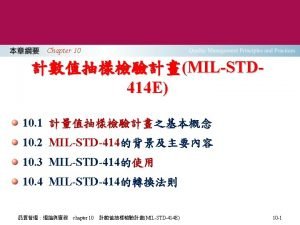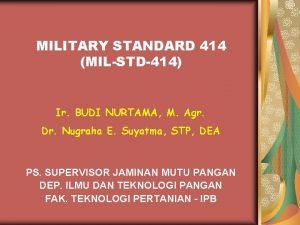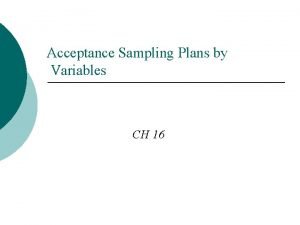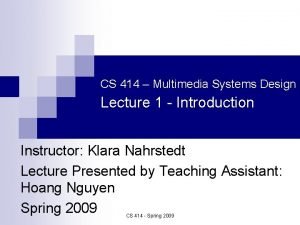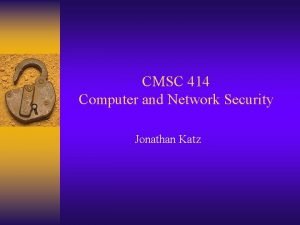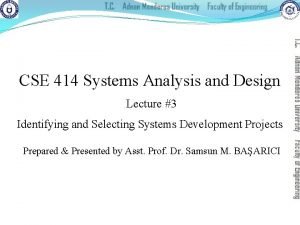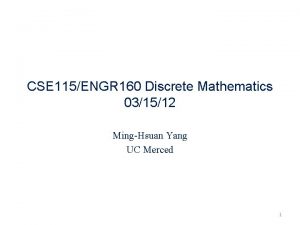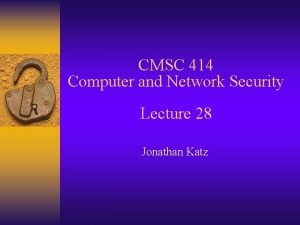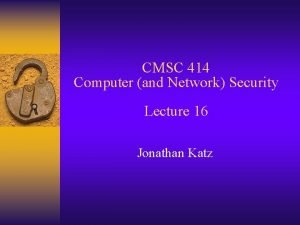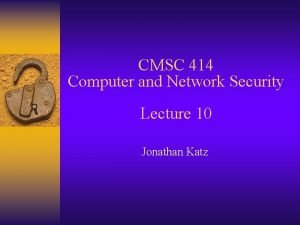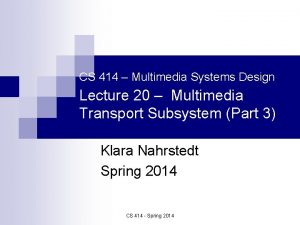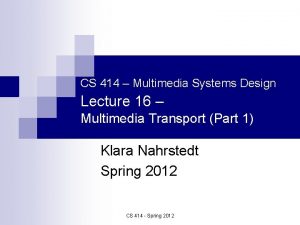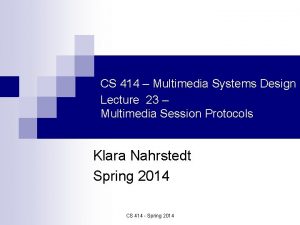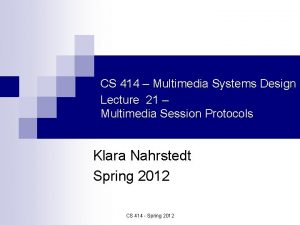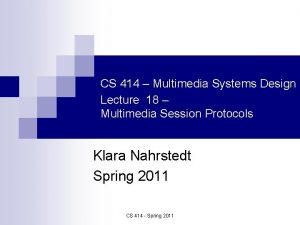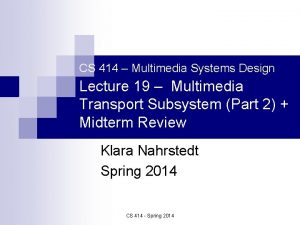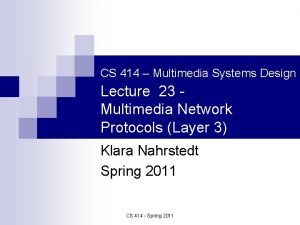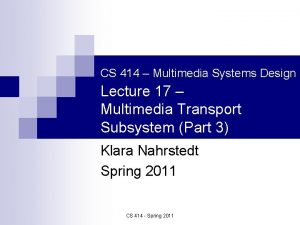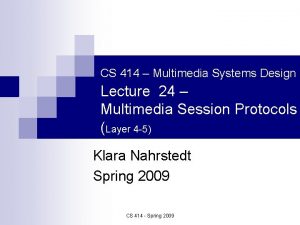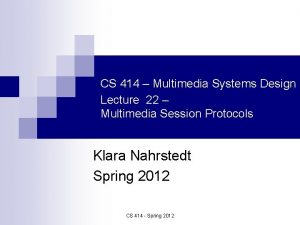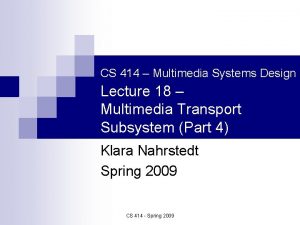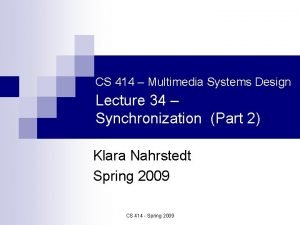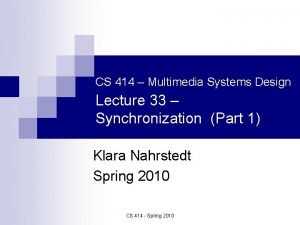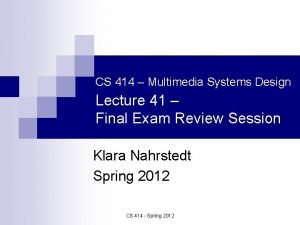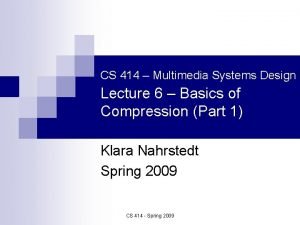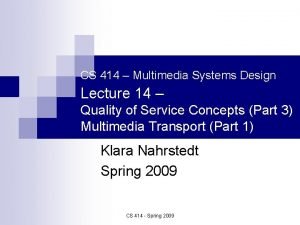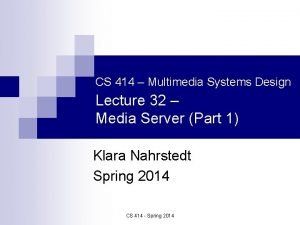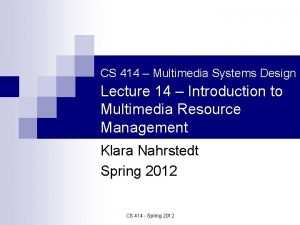CS 414 Multimedia Systems Design Lecture 16 Multimedia
























- Slides: 24

CS 414 – Multimedia Systems Design Lecture 16 – Multimedia Transport (Part 2) Klara Nahrstedt Spring 2011 CS 414 - Spring 2011

Administrative n n n HW 1: due on Wednesday, March 2 Midterm review session: Friday, March 4, in class Midterm: Monday March 7, in class Class canceled on Friday, March 11 due to EOH Android Tutorial ¨ Mar 1 st, 7 – 8: 30 pm, 2405 ¨ Mar 8 th, 8 – 9: 30 pm, 2405 CS 414 - Spring 2011

Outline n Data Streaming/Transmission Phase ¨ Traffic Shaping Isochronous Traffic Shaping n Shaping Bursty Traffic n ¨ Rate Control ¨ Error Control CS 414 - Spring 2011

Qo. S Enforcement – Traffic Shaping n n n In Packet Network, admission control, reservation is not sufficient to provide Qo. S guarantees Need traffic shaping at the entry to network and within network Traffic shaping ¨ Decides how packets will be sent into the network , hence regulates traffic ¨ Decides whether to accept a flow’s data ¨ Polices flows CS 414 - Spring 2011

Purpose of Traffic Shaping n Traffic shape ¨A way of a flow to describe its traffic to the network Based on traffic shape, network manager (s) can determine if flow should be admitted into the network n Given traffic shape, network manager(s) can periodically monitor flow’s traffic n CS 414 - Spring 2011

Example n If we want to transmit data of 100 Mbps, ¨ Traffic Shape A: Do we take 1 packet size of size 100 Mbit and send it once a second, or ¨ Traffic Shape B: Do we take 1 packet of size 1 Kbit and send it every 10 microseconds? A 1 Mbit Kth second K+1 th second B CS 414 - Spring 2011

Flow’s Traffic Shape Parameters (Network Qo. S) n Traffic Envelope ¨ Peak rate ¨ Average rate ¨ Burst length ¨ Burst duration n Service Envelope ¨ Maximum tolerable delay ¨ Desired delay jitter ¨ others CS 414 - Spring 2011

Source Classification n Classification of sources : ¨ Data – bursty, weakly periodic, strongly regular ¨ Audio – continuous, strong periodic, strong regular ¨ Video – continuous, bursty due to compression, strong periodic, weakly regular n Classification of sources into two classes: ¨ Constant ¨ Variable Bit Rate (CBR) – audio Bit rate (VBR) – video, data CS 414 - Spring 2011

Bandwidth Allocation n CBR traffic (shape defined by peak rate) ¨ CBR source needs peak rate allocation of bandwidth for congestion-free transmission n VBR traffic (shape defined by average and peak rate) ¨ average rate can be small fraction of peak rate n n underutilization of resources can occur if pessimistic allocation (peak rate allocation) is applied Losses can occur if optimistic allocation (average rate allocation) is applied CS 414 - Spring 2011

Isochronous Traffic Shaping (Simple Leaky Bucket Traffic Shaper) n Developed by Jon Turner, 1986 (Washington University, St. Louis) CS 414 - Spring 2011

Example n Consider for audio flow, size of the bucket ¨ β = 16 Kbytes Packet size = 1 Kbytes (one can accumulate burst up to 16 packets in the bucket) ¨ Regulator’s rate ρ = 8 packets per second, or 8 KBps or 64 Kbps ¨ n Consider video flow, size of bucket ¨ β = 400 Kbytes ¨ Packet size = 40 Kbytes (burst of 10 packets) ¨ Regulator’s rate ρ = 5 packets per second, 200 KBps, 1600 Kbps CS 414 - Spring 2011

Isochronous Traffic Shaping (r, T)-smooth Traffic Shaper Developed by Golestani, 1990 n Part of stop-and-go queuing/scheduling algorithm n Traffic divided into T-bits frames, where T is fixed n r-bits packet size per flow is considered, where r varies on a per flow basis n CS 414 - Spring 2011

(r, T) Traffic Shaper T-bits frames, sent every T-bit times r-bits packets r≤T • Flow Time line is permitted to inject no more than r bits of data into the network frame in any T bit times • if the sender wants to send more than one packet of r-bits, it must wait for next T-bit frame. • A flow that obeys this rule has (r, T)-smooth traffic shape. CS 414 - Spring 2011

Comparison • It is relaxed from the simple leaky bucket traffic shaper because Rather than sending one packet of size c every 1/ρ time units, (in simple leaky bucket ) • The flow can send c*k bits every 1/ρ time units , where k is T-bits times within the period 1/ρ • 1/ρ K=2 CS 414 - Spring 2011

Limitations of Isochronous Traffic Shaping In case of (r, T)-smooth traffic shaping, one cannot send packet larger than r bits long, i. e. , unless T is very long, the maximum packet size may be very small. n The range of behaviors is limited to fixed rate flows n Variable flows must request data rate equal to peak rate which is wasteful n CS 414 - Spring 2011

Isochronous Traffic Shaping with Priorities n n n Idea: if a flow exceeds its rate, excess packets are given lower priority If network is heavily loaded, packets will be preferentially dropped Decision place to assign priority ¨ At n ¨ In n the sender Application marks its own packets since application knows best which packets are less important the network (policing) Network marks overflow packets with lower priority CS 414 - Spring 2011

Shaping Bursty Traffic Patterns (Token Bucket) CS 414 - Spring 2011

Token Bucket n n The effect of TB is different than Leaky Bucket (LB) Consider sending packet of size b tokens (b<β): ¨ Token bucket is full – packet is sent and b tokens are removed from bucket ¨ Token bucket is empty – packet must wait until b tokens drip into bucket, at which time it is sent ¨ Bucket is partially full – let’s consider B tokens in bucket; n n if b ≤ B then packet is sent immediately, Else wait for remaining b-B tokens before being sent. CS 414 - Spring 2011

Comparison between TB and LB Token Bucket Simple Leaky Bucket TB permits burstiness, but bounds it LB forces bursty traffic to smooth out Burstiness is bounded as follows: - Flow never sends more than β+τ*ρ tokens worth of data in interval τ and - Long-term transmission rate will not exceed ρ Flow never sends faster than ρ worth of packets per second TB does not have discard or priority policy LB has priority policy TB more flexible LB is rigid TB is easy to implement -Each flow needs counter to count tokens, - each flow needs timer to determine when to add new tokens to the counter LB is easy to implement CS 414 - Spring 2011

Token Bucket Limitation n Difficulty with policing ¨ At any time the flow is allowed to exceed rate by number of tokens n Reasoning ¨ At any period of time, flow is allowed to exceed rate ρ by β tokens ¨ If network tries to police flows by simply measuring their traffic over intervals of length τ, flow can cheat by sending β+τ*ρ tokens of data in every interval. ¨ Flow can send data equal to 2β+2τ*ρ tokens in the interval 2τ and it is supposed to send at most β+2τ*ρ tokens worth of data CS 414 - Spring 2011

Token Bucket with Leaky Bucket Rate Control TB allows for long bursts and if the bursts are of high-priority traffic, they may interfere with other high-priority traffic n Need to limit how long a token bucket sender can monopolize network n CS 414 - Spring 2011

Composite Shaper CS 414 - Spring 2011

Composite Shaper Combination of token bucket with leaky bucket n Good policing n ¨ But remains hard, although confirming that the flow’s data rate does not exceed C is easy n More complexity for implementation ¨ Each flow requires two counters and two timers (one timer and one counter for each bucket) CS 414 - Spring 2011

Conclusion Traffic Shaping happens at the entry to the network n It is a very important function to regular and police traffic at the edges to avoid huge bursts coming into the network n CS 414 - Spring 2011
 01:640:244 lecture notes - lecture 15: plat, idah, farad
01:640:244 lecture notes - lecture 15: plat, idah, farad 0 414
0 414 Mil std 414
Mil std 414 Mil-std 414
Mil-std 414 414 climate change
414 climate change Cs 414
Cs 414 Cmsc 414
Cmsc 414 Cse414
Cse414 Gcd of 414 and 662
Gcd of 414 and 662 Cmsc 414
Cmsc 414 Cmsc 414
Cmsc 414 Cmsc 414
Cmsc 414 Operating system lecture notes
Operating system lecture notes Articulators
Articulators Lecture sound systems
Lecture sound systems Multimedia becomes interactive multimedia when
Multimedia becomes interactive multimedia when What is multimedia
What is multimedia Multimedia becomes interactive multimedia when
Multimedia becomes interactive multimedia when Esa multimedia.esa.int./multimedia/virtual-tour-iss
Esa multimedia.esa.int./multimedia/virtual-tour-iss Practical design to eurocode 2 lecture 3
Practical design to eurocode 2 lecture 3 Elemen urban design
Elemen urban design Elements and principles of design ppt
Elements and principles of design ppt Lecture hall acoustics
Lecture hall acoustics Game design lecture
Game design lecture Computer aided drug design lecture notes
Computer aided drug design lecture notes

